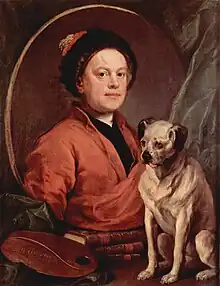Portal:London/Showcase biography/03 2010
William Hogarth (10 November 1697 – 26 October 1764) was a major English painter, printmaker, pictorial satirist, social critic and editorial cartoonist who has been credited with pioneering western sequential art. His work ranged from realistic portraiture to comic strip-like series of pictures called "modern moral subjects". Much of his work poked fun at contemporary politics and customs; illustrations in such style are often referred to as "Hogarthian".

Hogarth's major works often satirised the political and social life of London. They included the sequences A Harlot's Progress, A Rake's Progress, Marriage à-la-mode, Industry and Idleness, Beer Street and Gin Lane, and The Four Stages of Cruelty. Some were painted to influence political events, such as the passing of the Gin Act 1751; some to support philanthropic endeavours, such as those in the Foundling Hospital and on the grand staircase of St Bartholomew's Hospital.
Hogarth's House in Chiswick, west London, is now a museum; it abuts one of London's best known road junctions – the Hogarth Roundabout. Examples of his work can be seen in the National Gallery, Tate Britain and Sir John Soane's Museum.